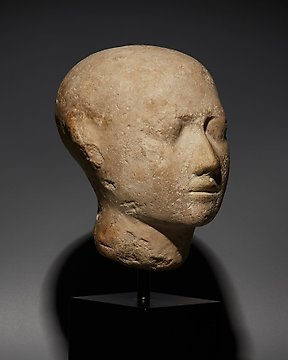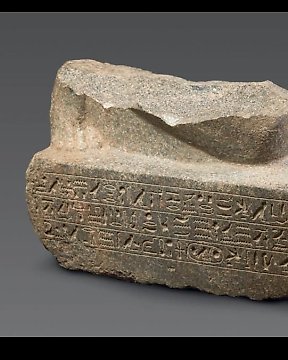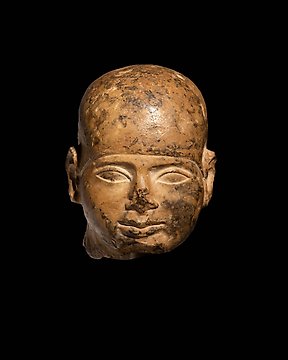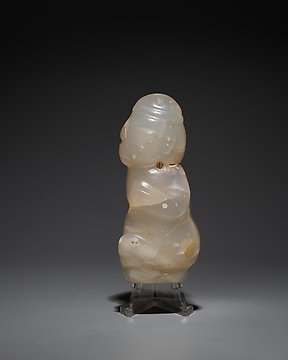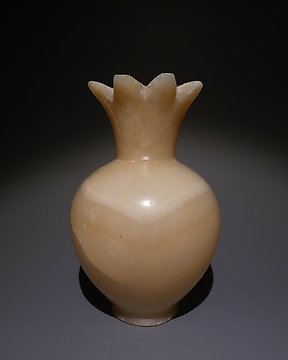All OK and with very fast shipping.
查看翻譯古埃及 木 沙布蒂,新王國,第十八至十九王朝,西元前 1552 年至 1186 年。高度 21.9 公分。
編號 84871125

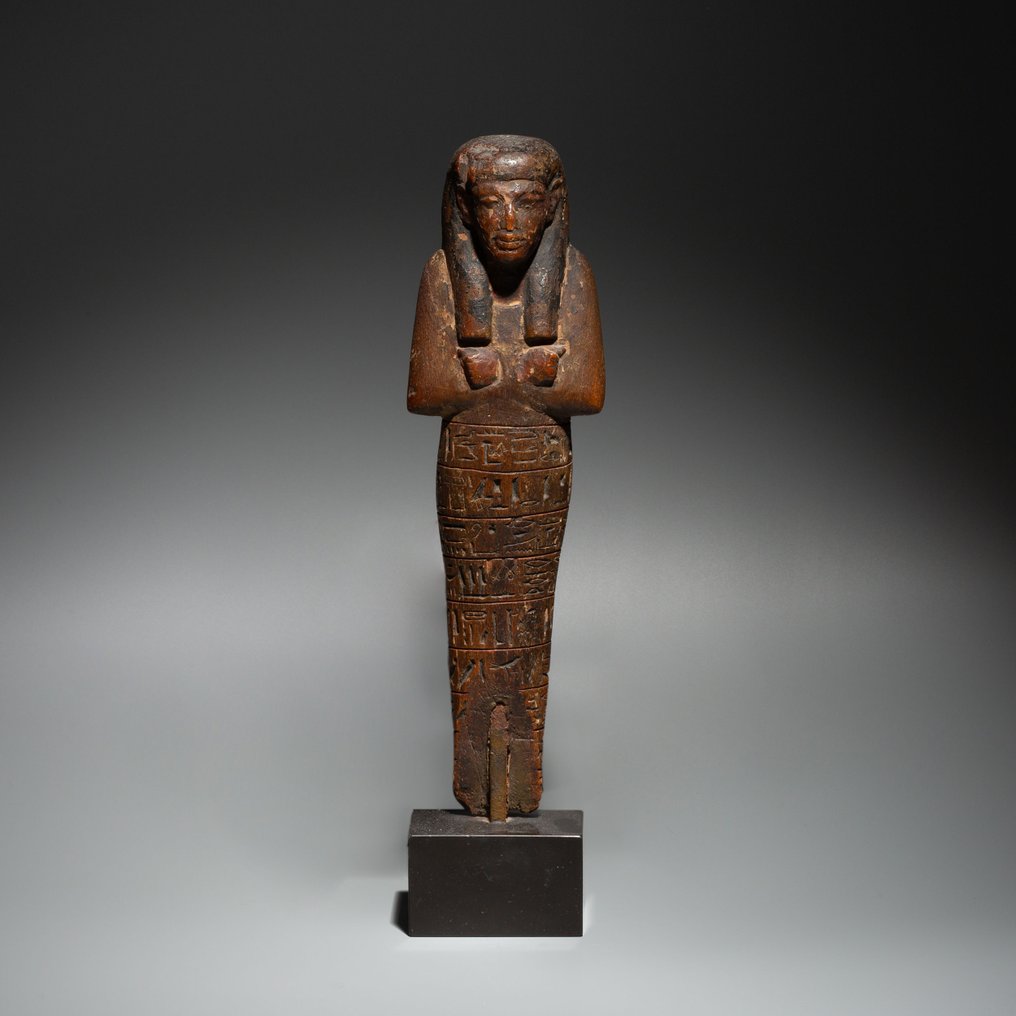

Ushebti.
- Good Quality! -
- Important Piece! -
Ancient Egypt, New Kingdom, 18th - 19th Dynasty, 1552 - 1186 BC.
MATERIAL: Wood and pigments.
DIMENSIONS: Height 21.9 centimeters.
PROVENANCE: - Private collection, Switzerland. Acquired around 1970.
CONDITION: Good condition, maintains the original polychrome, especially in the upper part. He has lost the lower part of his insteps and feet.
BIBLIOGRAPHY:
- BOVOT, J. Les serviteurs funeraires royaux et princiers de l'Ancienne Egypte. Paris: Editions de la Reunion des musees nationeuax, 2003.
- GLEEN, J. Shabtis, a private view. Paris: Librairie Cybele, 2002.
- SCHNEIDER, H. D. Shabtis. Leiden: Rijksmuseum van Oudheden, 1997.
- STEWART, H. M. Egypyian shabtis. United Kingdom: Shire Egyptology, 1995.
DESCRIPTION:
Ushabti figure carved in wood and later polychrome. He is wearing a tripartite wig that descends between his shoulders. From his mummiform shroud that covers his entire body, only his hands clenched into fists stand out, crossed over his chest. Due to the multitude of parallels, each hand would hold two hoes, agricultural tools, or a scepter and flagellum, which would be represented through the use of polychrome. On the body it has eight registers of horizontal hieroglyphic writing incised in bas-relief.
The Egyptian Afterlife was understood as a mirror of the real world, where good and evil also had their place. The unjust and evil were punished for all eternity, while the righteous enjoyed a comfortable existence traveling with the solar god. Even so, the blessed deceased were also obligated to fulfill human needs and responsibilities, just as they were in life; Having what to eat and drink in the Hereafter was a constant concern. In the Kingdom of the Dead, where, as members of a hierarchical society governed by the gods, all the deceased—men and women, lords and servants, kings and queens—were obliged to work in the Fields of Iaru. They had to be willing to cultivate, sow, and reap the harvest.
In earthly life these basic production tasks were performed by those belonging to the lowest levels of society. To avoid this fate, the Egyptians sought a magical solution: they had one or more figures of themselves made to present when the emissaries of the reigning god Osiris called upon them to fulfill their obligations. Thus, these statuettes, incorporated into the funerary trousseau of the tomb, were images that represented both the master and the servant.
They are known by the name ushebtis , the initial word being sabty or shabty , a derivative of Sawab , whose meaning corresponds to the Greek word " persea ", a sacred tree with which the ancient Egyptians began to make these funerary effigies. It is towards the Third Intermediate Period, in the 21st dynasty, around 1,080 BC when the word wsbty , that is: " ushebty " , begins to be used . It is from then on that " ushebti " derives from the verb wsb , "to respond", whose meaning is "the one who responds."
Ushebtis were incorporated into the graves of ancient Egypt beginning in the First Intermediate Period. Its use increased during the Middle Kingdom, when the Egyptians began to write in the Sarcophagus Texts a formula, 472, for the ushabtis to respond to the call: «The Justified N., says, Oh you shabty , who You have been made for N, if N is called to his tasks, or if an unpleasant job is imposed on N as on any man in his work, you will say here I am. If N is called to watch over those who work there, returning over the new fields to plow the land, or to transport sand from east to west by boat, you will say here I am. The Justified N. This formula is written on the ushabtis , thus, in most cases, they appear engraved. Starting with the New Kingdom, a large number of innovations were introduced and examples with texts began to proliferate, somewhat broader texts, contemplated in chapter VI of the Book of the Dead. Even so, in many cases the text indicates only the name of the deceased, or a basic formula, with the name of a relative or the most important positions he held.
The ushabtis were made of wax, especially in the beginning, later in wood, and towards the end of the Middle Kingdom stone appeared, and from the New Kingdom the material par excellence would be faience. It is known that they were produced in series thanks to the conservation of molds since in some cases the engraved texts were unfinished, since the name of the owner was missing. Its most popular form was the mummy, until the introduction, towards the end of the 18th dynasty, of figures decorated with everyday dresses. Many carried tools for working the land, such as a basket, a pickaxe, or a hoe, as a reference to the task they were expected to perform in the Hereafter on behalf of their masters. The iconography, texts, materials, colors and their location in the tomb may suggest other symbolic meanings.
Sometimes they were placed inside wooden boxes, which could be ostentatious in terms of decoration or very simple. In the New Kingdom they came to be placed in miniature sarcophagi.
While at the beginning they were considered replicas of the extinct, in the New Kingdom and later, they came to be seen as servants or a kind of slave of the inanimate, which is why large quantities were produced. At first an ushabti was made for the deceased, however, as the different dynasties passed, large quantities of these statuettes were made for the deceased, made up of men and women, including specialists in different activities, who were sometimes directed by foremen who managed to differentiate themselves by wearing a skirt. Such is the case of Pharaoh Tutankhamun who had three hundred and sixty-five ushabtis at his disposal , one for each day of the year; thirty-six foremen, one for each group of ten workers, and twelve month leaders, one for each month of the year. This made a total of four hundred and thirteen servants in the Hereafter. Such was the fear of carrying out these actions demanded by Osiris that some burials included ushebtis who acted as "substitutes" for the main ones.
It is logical to think that no pharaoh wanted to carry out this type of task with his hands, so at the required moment he read the legend written on the body of the ushabti and it came to life to respond to the call, replacing him in the work.
Notes:
- The piece includes authenticity certificate.
- The piece includes Spanish Export License (Passport for European Union) - If the piece is destined outside the European Union a substitution of the export permit should be requested, can take between 1-2 weeks maximum.
- The seller guarantees that he acquired this piece according to all national and international laws related to the ownership of cultural property. Provenance statement seen by Catawiki.
賣家的故事
Ushebti.
- Good Quality! -
- Important Piece! -
Ancient Egypt, New Kingdom, 18th - 19th Dynasty, 1552 - 1186 BC.
MATERIAL: Wood and pigments.
DIMENSIONS: Height 21.9 centimeters.
PROVENANCE: - Private collection, Switzerland. Acquired around 1970.
CONDITION: Good condition, maintains the original polychrome, especially in the upper part. He has lost the lower part of his insteps and feet.
BIBLIOGRAPHY:
- BOVOT, J. Les serviteurs funeraires royaux et princiers de l'Ancienne Egypte. Paris: Editions de la Reunion des musees nationeuax, 2003.
- GLEEN, J. Shabtis, a private view. Paris: Librairie Cybele, 2002.
- SCHNEIDER, H. D. Shabtis. Leiden: Rijksmuseum van Oudheden, 1997.
- STEWART, H. M. Egypyian shabtis. United Kingdom: Shire Egyptology, 1995.
DESCRIPTION:
Ushabti figure carved in wood and later polychrome. He is wearing a tripartite wig that descends between his shoulders. From his mummiform shroud that covers his entire body, only his hands clenched into fists stand out, crossed over his chest. Due to the multitude of parallels, each hand would hold two hoes, agricultural tools, or a scepter and flagellum, which would be represented through the use of polychrome. On the body it has eight registers of horizontal hieroglyphic writing incised in bas-relief.
The Egyptian Afterlife was understood as a mirror of the real world, where good and evil also had their place. The unjust and evil were punished for all eternity, while the righteous enjoyed a comfortable existence traveling with the solar god. Even so, the blessed deceased were also obligated to fulfill human needs and responsibilities, just as they were in life; Having what to eat and drink in the Hereafter was a constant concern. In the Kingdom of the Dead, where, as members of a hierarchical society governed by the gods, all the deceased—men and women, lords and servants, kings and queens—were obliged to work in the Fields of Iaru. They had to be willing to cultivate, sow, and reap the harvest.
In earthly life these basic production tasks were performed by those belonging to the lowest levels of society. To avoid this fate, the Egyptians sought a magical solution: they had one or more figures of themselves made to present when the emissaries of the reigning god Osiris called upon them to fulfill their obligations. Thus, these statuettes, incorporated into the funerary trousseau of the tomb, were images that represented both the master and the servant.
They are known by the name ushebtis , the initial word being sabty or shabty , a derivative of Sawab , whose meaning corresponds to the Greek word " persea ", a sacred tree with which the ancient Egyptians began to make these funerary effigies. It is towards the Third Intermediate Period, in the 21st dynasty, around 1,080 BC when the word wsbty , that is: " ushebty " , begins to be used . It is from then on that " ushebti " derives from the verb wsb , "to respond", whose meaning is "the one who responds."
Ushebtis were incorporated into the graves of ancient Egypt beginning in the First Intermediate Period. Its use increased during the Middle Kingdom, when the Egyptians began to write in the Sarcophagus Texts a formula, 472, for the ushabtis to respond to the call: «The Justified N., says, Oh you shabty , who You have been made for N, if N is called to his tasks, or if an unpleasant job is imposed on N as on any man in his work, you will say here I am. If N is called to watch over those who work there, returning over the new fields to plow the land, or to transport sand from east to west by boat, you will say here I am. The Justified N. This formula is written on the ushabtis , thus, in most cases, they appear engraved. Starting with the New Kingdom, a large number of innovations were introduced and examples with texts began to proliferate, somewhat broader texts, contemplated in chapter VI of the Book of the Dead. Even so, in many cases the text indicates only the name of the deceased, or a basic formula, with the name of a relative or the most important positions he held.
The ushabtis were made of wax, especially in the beginning, later in wood, and towards the end of the Middle Kingdom stone appeared, and from the New Kingdom the material par excellence would be faience. It is known that they were produced in series thanks to the conservation of molds since in some cases the engraved texts were unfinished, since the name of the owner was missing. Its most popular form was the mummy, until the introduction, towards the end of the 18th dynasty, of figures decorated with everyday dresses. Many carried tools for working the land, such as a basket, a pickaxe, or a hoe, as a reference to the task they were expected to perform in the Hereafter on behalf of their masters. The iconography, texts, materials, colors and their location in the tomb may suggest other symbolic meanings.
Sometimes they were placed inside wooden boxes, which could be ostentatious in terms of decoration or very simple. In the New Kingdom they came to be placed in miniature sarcophagi.
While at the beginning they were considered replicas of the extinct, in the New Kingdom and later, they came to be seen as servants or a kind of slave of the inanimate, which is why large quantities were produced. At first an ushabti was made for the deceased, however, as the different dynasties passed, large quantities of these statuettes were made for the deceased, made up of men and women, including specialists in different activities, who were sometimes directed by foremen who managed to differentiate themselves by wearing a skirt. Such is the case of Pharaoh Tutankhamun who had three hundred and sixty-five ushabtis at his disposal , one for each day of the year; thirty-six foremen, one for each group of ten workers, and twelve month leaders, one for each month of the year. This made a total of four hundred and thirteen servants in the Hereafter. Such was the fear of carrying out these actions demanded by Osiris that some burials included ushebtis who acted as "substitutes" for the main ones.
It is logical to think that no pharaoh wanted to carry out this type of task with his hands, so at the required moment he read the legend written on the body of the ushabti and it came to life to respond to the call, replacing him in the work.
Notes:
- The piece includes authenticity certificate.
- The piece includes Spanish Export License (Passport for European Union) - If the piece is destined outside the European Union a substitution of the export permit should be requested, can take between 1-2 weeks maximum.
- The seller guarantees that he acquired this piece according to all national and international laws related to the ownership of cultural property. Provenance statement seen by Catawiki.
賣家的故事
- 744
- 6
- 0
Prachtig schilderij. Zo blij mee. Zeer nette verkoper en zeer snelle levering.
查看翻譯perfect ! very fast and high quality delivery !
查看翻譯All well! Thanks.
查看翻譯Vendeur très professionnel, top +++×
查看翻譯Photos trop contrastées pour bien percevoir les défauts, mais ces défauts étaient visibles pour autant. Le "Bon état" est trompeur. Sinon, envoi rapide et correctement emballé. Frais de port exagérés.
查看翻譯Great communication, delivery and product. Came with a well made certificate of authenticity and good packaging. Overall very happy with the purchase! Delivery is a bit expensive, but I recommend it
查看翻譯Magnifique témoin du passé, envoyé avec tous les justificatifs, impeccable. Encore une fois très satisfait, un grand merci
查看翻譯Thank you for the Special offer and the fast shipping of this excellent piece of art!
查看翻譯very good description of the object, very good price for this rare item,. Fast sending (has been at my place 2 days after buying!). Definitely would buy again.
查看翻譯Sehr schön
查看翻譯As described, perfect logistic
查看翻譯great seller, everything came as should with certificate of authenticity
查看翻譯Exceptionally well packaged, description aligned with positing received
查看翻譯Really precious, but without sound...
查看翻譯Painting well packed and rapidly sent!
查看翻譯sempre grande rapidità e professionalità
查看翻譯parfait bien reçu, merci
查看翻譯Very satisfied with the small Greek Lekythos. As always (we have already bought several items from Bagot), the object was wrapped and sent immediately and with the greatest care.
查看翻譯Perfect, excellent condition, good packaging, the parcel arrived without any problems… all is perfect as usual. Thank you very much and wait for an other nice piece like this one. Gilles.
查看翻譯+++ Top vendeur professionnel comme d'habitude
查看翻譯Embora o custo de transporte esteja acima da média foi, realmente, muito bem executado e em embalagem cuidada. Expeditos e profissionais. Recomendo
查看翻譯Snel en correct en goed verpakt verzonden
查看翻譯oggetto bellissimo, fedele alla descrizione, venditore affidabile
查看翻譯Very nice piece and fast delivery
查看翻譯免責聲明
賣家保證並能證明該物品是合法取得的。 Catawiki 通知賣家,他們必須提供其居住國法律要求的文件。 賣家保證並有權出售/出口此物品。 賣家將向買家提供有關該物品的所有已知來源的資訊。 賣家確保已/將安排任何必要的許可證明。 賣家將立即通知買家有關獲得此類許可時的任何延誤。
賣家保證並能證明該物品是合法取得的。 Catawiki 通知賣家,他們必須提供其居住國法律要求的文件。 賣家保證並有權出售/出口此物品。 賣家將向買家提供有關該物品的所有已知來源的資訊。 賣家確保已/將安排任何必要的許可證明。 賣家將立即通知買家有關獲得此類許可時的任何延誤。

